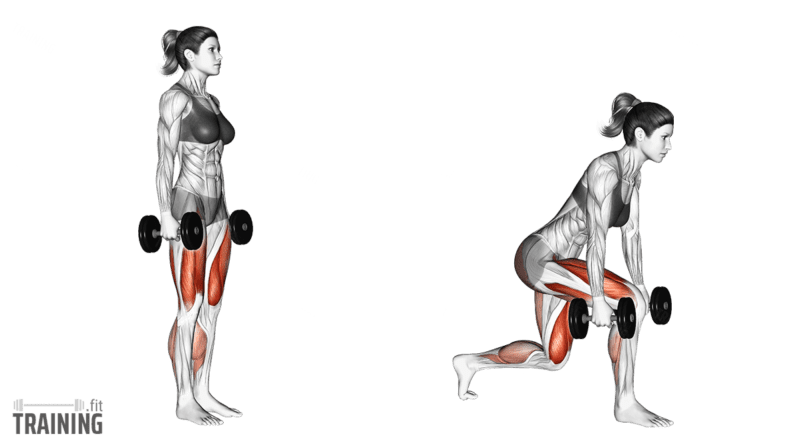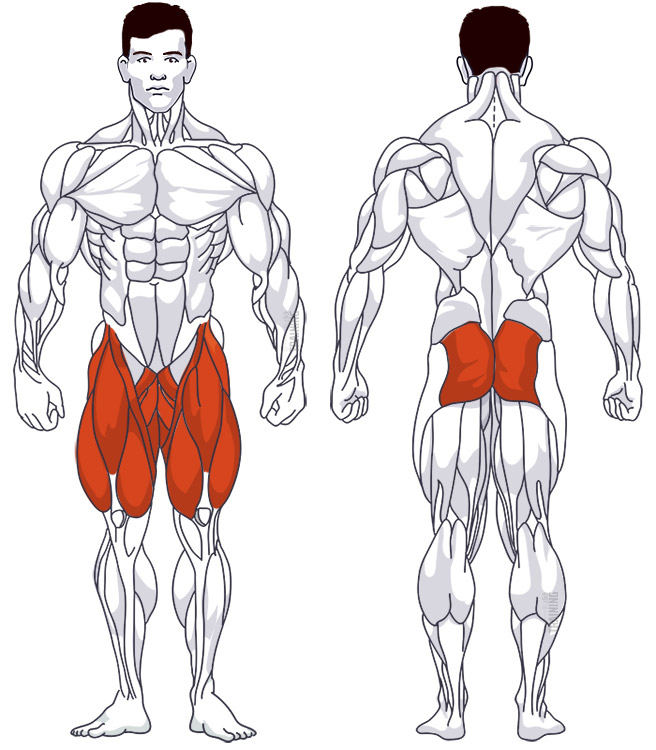Dumbbell Lunges
Isolation exercise, Free weightsOverview

Main muscles
- Thigh: Quadriceps
(Musculus quadriceps femoris) - Buttocks: Large gluteus maximus
(Musculus gluteus maximus)
Training plans
Dumbbell Lunges is a suitable substitute for similar exercises in Thigh training or as a supplement to various training plans.
Dumbbell Lunges: Basics and alternatives

Involved main muscle groups:
Dumbbell Lunges
The dumbbell lunge is a variation of the classic bodyweight lunge. This exercise is a great alternative or addition to step-ups. You can also do lunges with a barbell. Just like the other two variations, you’ll take a controlled big step forward with dumbbell lunges.
This exercise is perfect for home workouts since all you need are the dumbbells. Just clear a little space for your steps. The dumbbell lunge is beginner-friendly as it provides a good muscle sensation and helps improve balance.
Like the classic lunge without dumbbells, this exercise mainly targets your front thigh (quadriceps) and glutes.
Correct execution
To do this exercise properly, you’ll need some space. Taking a bigger step activates the gluteal muscle more, while a smaller step focuses more on your thigh. Aim for equal load on both muscle regions as much as possible. If you do this exercise several times a week, try varying your step length daily to challenge the muscle parts differently and optimize recovery time.
The following describes lunges with dumbbells in one continuous movement. Alternatively, the exercise can be performed in a stationary position, as described here.
The video also demonstrates a “walking” lunge. You’ll move around the room while performing the exercise. You can do this type of exercise by training one leg within the reps or alternating your legs as you would when walking (see video). For this type of execution, you’ll need more space in front of you. One advantage of the walking dumbbell lunge is the greater range of motion, which puts more stress on your posterior thigh.
Video tutorial
Step-by-step instructions
Stand upright, about hip-width, with the dumbbells at your sides in your hands.
Take a big step forward with the leg you want to train first.
After performing the step, lower your torso straight down. Your front leg (training leg) carries your weight, while the other leg stabilizes your body. Stand firmly on your front foot and on your back foot’s toes, with the heel in the air.
During the downward motion, make sure your front knee doesn’t push in front of your toes. If this happens, your step is too small or your torso is bent too far forward. The angle between your upper and lower leg of the training leg should be about 90 degrees.
The knee of your stabilizing leg should only lightly touch the ground, if at all, during the downward movement. Don’t release tension in your training leg by kneeling down with the other leg.
At the end of the downward movement, push your upper body up with your training leg.
You can now do the second repetition directly with your second leg, or first complete all reps with one leg and then the other leg.
Common mistakes
If your step is too small or your torso is bent forward too much, the knee of your training leg will push in front of your toes. This shouldn’t happen, as it puts unnecessary stress on the joints and reduces muscle tension.
If your stride is too big, stability suffers, and you may experience too much unsteadiness. So it’s important to find the sweet spot for you by experimenting a bit with how to stand as securely as possible, while not making your step too small.
As mentioned earlier, the knee of the back leg shouldn’t touch the floor. Not only can this be painful, but it also reduces the training effect, because you’re taking weight off the training leg.